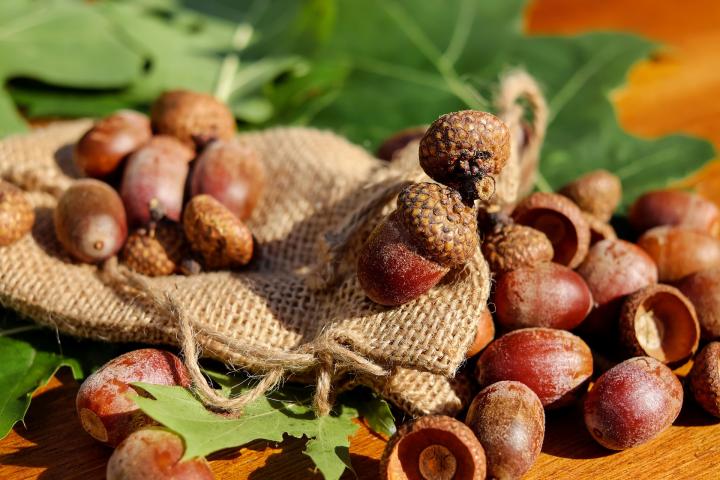It seems to be a great year for acorns in my area. The squirrels are all about them and the dogs are going crazy because of the squirrels.
Anyone ever process acorns and eat them? I have collected a handful here and there, but I have never done a full on processing of them for food.
https://www.almanac.com/content/how-prepare-and-cook-acorns
HOW TO PREPARE AND COOK ACORNS
A STEP-BY-STEP GUIDE TO PREPARING AND COOKING WITH ACORNS
By
The Editors
August 29, 2019
Acorns are extremely nutritious and readily available in nature, making them a healthy addition to many recipes. Here’s how to prepare and cook acorns!
Why acorns? They are incredibly nutritious with healthy levels of carbohydrates, protein and fiber. Surprisingly, they are also a good source of Vitamins A and C.
Plus, they have a wonderful rich, nutty taste. Also, why not? It’s fun to forage and try making something adventurous.
Many Native Americans have a long history of consuming acorns. Plus, acorns have been a staple around the world for many cultures from Asians to Europeans to Africans.
Most folks use acorns to make a nutrient-rich, nutty-flavored flour. You can also eat acorn as roasted nuts (they are a lot like chestnuts). See more ideas below.
WHERE AND WHEN TO FIND ACORNS
Acorns come from oak trees and can be found across North America. Oak trees are easily identifiable; they’re the ones with all the acorns that have fallen down around them!
They are typically “harvested” between September and November, when they fall from the trees and become easily accessible to deer, squirrels, and resourceful humans.
HOW TO COLLECT ACORNS
When gathering acorns, look for brown, fully mature acorns that still have their caps, as those without caps are more susceptible to infestation by worms and other critters.
Green acorns are not yet mature and shouldn’t be used.
HOW TO WASH ACORNS
- Give acorns a quick rinse in cool water. Place them in a pot or bowl and fill it with water, then remove and dispose of any floating acorns, as they have likely gone bad.
- Place the acorns in a colander and run them under the tap for a minute or two to dislodge any loose dirt or hitchhiking bugs.
- Set the colander aside to let the acorns air-dry, or simply dry them by hand with a dish towel.
- Remove the shells and caps from your acorns with a nutcracker (or a hammer, if necessary). Do not eat the raw meat of the acorns yet.
HOW TO LEACH ACORNS
Acorns contain bitter-tasting tannins, so you must prepare, treat and cook the nuts before you eat them. It sounds like a pain but it’s really not that difficult.
- Start two pots of water boiling. Drop the raw, shell-less acorns into one pot and boil until the water is the color of strong tea. Strain the nuts through a colander and drop the strained nuts into the second pot of boiling water. Discard the dark water from the first pot, then refill it and bring the water to a boil again. Repeat the process without interruption (do not let the acorns cool) until the water boils clear. This may take an hour or more, depending on the variety of acorn.
- Alternatively, you can soak the raw acorns in cold water to leach the tannins out. Change the water when it turns a darker color. This process may take several days, depending on how long it takes for all the tannins to leach out of the acorn meat.
It’s very important that the acorns dry to avoid rotting. Spread tannin-free acorns to dry on cookie sheets in a warm place. If it is hot out, lay the cookie sheets in the sun. Or, you could put them in an oven set to “warm.” You can also put the acorns in a dehydrator set on low heat.
EATING ROASTED ACORNS
Preheat your oven to 350 degrees Fahrenheit. Pour the acorns into a single layer on an ungreased, rimmed cookie sheet. Cook the nuts for about 60 minutes or until they turn a chocolate brown color. Remove the acorns from the oven and let them cool. Salt to taste.
HOW TO GRIND ACORNS FOR FLOUR
When partially dry, coarse grind a few acorns at a time in a blender. Spread the ground acorns to dry on cookie sheets, then grind again in a blender. Repeat until you are left with a flour- or cornmeal-like substance.
You can also freeze your fresh acorn meal. Store dried flour in jars in the fridge.
ACORN RECIPE IDEAS
- Mix up cooked acorns with raisins or other dried fruit to make a trail mix.
- Substitute acorns for chestnuts in baking recipes.
- Use acorn flour in bread, cake, pancakes, and more! Try this acorn flour flatbread recipe (similar to tortilla).
- Or, try this acorn flour honey cake tastes a little like gingerbread cake.
- The flour also makes an excellent pasta dough when mixed with regular flour.
- How about adding acorn flour to a pancake recipe for that nutty taste and nutrition?
Acorn Pancakes Recipe
This recipe adapted from Sharon Hendricks.
Source: Texas A&M University AgriLife Extension
Ingredients:
- One egg
- 1 tsp. salad oil
- 1 tsp. honey or sugar
- ½ cup leached and ground acorns
- ½ cup cornmeal
- ½ cup whole wheat or white flour
- 2 tsp. double action baking powder
- ½ tsp. salt
- ½ cup milk
Instructions:
Break egg into bowl and add all ingredients, beating to create a batter. If batter is too thick, thin with additional milk. Pour batter onto hot, greased griddle and cook slowly until brown. Flip to brown opposite side. Serve with butter and syrup or jam—and enjoy!



















































